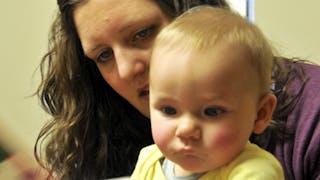Bethel Graduate Student and Professor Study the Thirty-Million-Word-Gap
News
April 17, 2014 | 2:44 p.m.
By Nicole Finsaas ’13 and Brianna Albers ’17

Chellie Sebald and her son Joel read together.
Bethel Associate Professor of Education Gail Jordan and graduate student Chellie Sebald have made strides researching the “Thirty-Million-Word-Gap,” exploring the disparity between the vocabularies of children of high and low socioeconomic statuses. Betty Hart and Todd R. Risley, prominent researchers throughout the 1960s, discovered that the vocabulary of children with a low socioeconomic status was 30 million words behind the vocabulary of children with a high socioeconomic status. While Hart and Risley’s “Thirty-Million-Word-Gap” is still true today, Jordan and Sebald are playing influential roles in minimizing that gap.
Sebald, a literacy coach for the Brooklyn Center community schools, Brooklyn Center, Minn., became interested in the problem when she first began working as a third grade teacher: “[I came across the research] initially knowing something was missing for my kids and searching for that,” she explains. In teaching, she’s seen the effect of the gap on a daily basis. “The kids can become very good word solvers,” she says, “but they lack a lot of comprehension and cannot really understand and make meaning from a conversation or a text. The problem started long before they entered my classroom.” When Sebald attended Jordan’s graduate class, she was finally able to put words to the problem: “The Early Catastrophe.”
Jordan, who serves as program director of Bethel’s Master’s in Literacy degree program, has also had experience in the classroom, developing Early Access to Success in Education (EASE) to help parents nurture a child’s language and literacy skills. A year’s worth of research on nearly 250 kindergarten students gave Jordan insight into language development and parental influence. Jordan’s work was noticed by experts in the field, and last fall she was invited to participate in think tank, sponsored by the White House, comprising literacy experts, policy makers, and other influential researchers. “It was an exciting opportunity to be included in this national discussion,” she says.
The “Thirty-Million-Word-Gap” has since become a national health initiative. The team has set a goal of closing 50% of the gap in five years through public awareness, community support, and a federal partnership. “The project seeks to support language and literacy development for all children regardless of socioeconomic status,” says Jordan. “That is a very noble endeavor.”
While Jordan plans to attend future meetings in an attempt to further minimize the word gap, she has also been busy on the local literacy front. In January 2014, she received the Minnesota Academy of Reading’s Celebrate Literacy Award for her significant contributions to the literacy landscape in Minnesota and beyond, including chairing the Minnesota English Language Arts K-12 Common Core Standards committee, working on the development of the Board of Teaching Reading standards for all Minnesota teachers, and chairing the Minnesota Department of Education development of language and literacy standards for birth through age 5. She has served on a number of state-level committees such as the Governor’s Council on Reading Excellence, the State Leadership Council on Literacy, and the Minnesota Literacy Coalition, and has worked collaboratively with Harvard University and University of Michigan scholars.